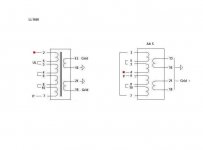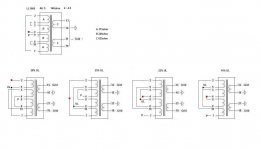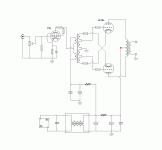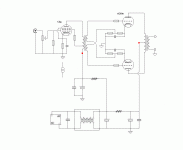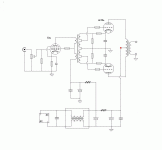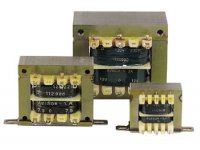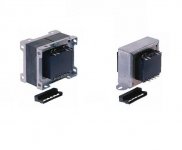The higher output resistance in UL will probably give you problems with the bandwith of the trafo.
Looking at LL1660, there are several alternatives coupled for a 15kohm source
and still with good bandwidth, 20-25khz
hmm, UL tapped load is supposed to work between 15-50% "tap"
at higher percentage "tap" we are approaching penthode load, and with lesser, more triode load
we are not aiming at minimum distortion, nor maximum output
what we want is lower impedance
so I guess a smaller percentage UL tap is where we want to be
at higher percentage "tap" we are approaching penthode load, and with lesser, more triode load
we are not aiming at minimum distortion, nor maximum output
what we want is lower impedance
so I guess a smaller percentage UL tap is where we want to be
...
we are not aiming at minimum distortion, nor maximum output
what we want is lower impedance
so I guess a smaller percentage UL tap is where we want to be
So why UL? Or, what's not to like with triode connection in this application?
Anything built, yet?
So why UL? Or, what's not to like with triode connection in this application?
Anything built, yet?
I meant to say lower distortion than in direct triode couple
or in other words, to use UL tapped IT, and optimise the coupling for low impedance instead of lowest distortion
direct triode coupled should work very well, though to me it seems like kind of brute force
but now the interstage is there, UL tapped seems more elegant, to me
surely not the easy road
but whatever, there may be something good to learn
no, nothing built yet, but tubes are bought
enough tubes to run it for its entire relevant lifetime
and relatively cheap NOS tubes of very high quality
thats one choise I made, to not worry about tubes in a few years, and the cost of them
that is, if it works, or I could possibly burn all of them in no time
I hate that thought, but ofcourse noone knows for sure
we have been through several different schematics
probably even good and functional ones
tubes are in house, and this is the final design
trafos are next on the list, but not quite there yet
Attachments
Tube amp circuits are relatively simple. So I'd suggest just breadboard what you have (on a piece of wood or whatever by hardwirings) and fire it up to see what happens. It may probably sing beatifully at the first time😀 Who knows? After that, you do the mods and other experiments. Well, that's what I do.
Just my 2c. 🙂
Just my 2c. 🙂
What looks good on paper is often not the best sounding end result. As CLS said, only the suck it and see option can distinguish between your different ideas.
Personally i have my doubts about the UL approach - but a simple wire switch will reveal the truth.
What I can say is that these regulator valve amps sound better than any other amps I have heard - mainly because they avoid the fault of most valve amps, which is woolly bass.
Shoog
Personally i have my doubts about the UL approach - but a simple wire switch will reveal the truth.
What I can say is that these regulator valve amps sound better than any other amps I have heard - mainly because they avoid the fault of most valve amps, which is woolly bass.
Shoog
yeah, if nothing else, at least triode coupled will work, that we know for sure
time to build, eh

thank you all, you have been most helpful
time to build, eh


thank you all, you have been most helpful

Hey, serious now
Supply trafos
I have found a cheap 9V toroid for dc heaters
And ok price on main trafo, 350mA with multitap, 0-140-160-180-200V
but I can get different voltage taps
would you suggest other voltage ratings ????????
btw, its the C3g-6C19n.....ECC88-6C19n(Revintage) is for reference
Supply trafos
I have found a cheap 9V toroid for dc heaters
And ok price on main trafo, 350mA with multitap, 0-140-160-180-200V
but I can get different voltage taps
would you suggest other voltage ratings ????????
btw, its the C3g-6C19n.....ECC88-6C19n(Revintage) is for reference
Attachments
DC heaters are entirely a waste of time and money except in very exceptional circumstances.
Shoog
Shoog
DC heaters are entirely a waste of time and money except in very exceptional circumstances.
Shoog
I thought it was best to have a steady 6.3V
C3g allows only a 5% deviation....thats only 0.3V 😕
The exceptions are Indirectly heated triodes, phono and mic preamps. Anything else will work just fine without DC heaters, and there is even a case for saying that incorrectly implemented DC may even degrade the sound quality.
None of my amps or preamps use DC heaters - and all of them are wisper quiet.
These valves were primarily designed for AC (any one designed for battery operation tend to have lower voltages such as 2V or 5V), and so they are more than capable of sucking up a bit of line variation along the way.
Shoog
None of my amps or preamps use DC heaters - and all of them are wisper quiet.
These valves were primarily designed for AC (any one designed for battery operation tend to have lower voltages such as 2V or 5V), and so they are more than capable of sucking up a bit of line variation along the way.
Shoog
ok, I hear you
others say the same
I just thought...well, I guess not
AC it will be
some suggest its best to use center tapped trafo
or create a CT ground reference with resistors
buggers, its impossible to find cheap heater trafo with accurate voltage
the one I found is 9V
hmm, hope it will be ok to adjust voltage by resitors ?????
or a bit of unwinding maybe
others say the same
I just thought...well, I guess not
AC it will be
some suggest its best to use center tapped trafo
or create a CT ground reference with resistors
buggers, its impossible to find cheap heater trafo with accurate voltage
the one I found is 9V
hmm, hope it will be ok to adjust voltage by resitors ?????
or a bit of unwinding maybe

EI transformers are best because they filter out line hash, which will bleed from the heaters to the cathodes, toroidals let it all through. The effect maybe minimal - but if you live in a very dirty supply area - maybe it wont be. Going DC would make this even worse because the massive charging spikes become harmonic spikes throughout the circuit.
It maybe OK to use a 9V toroidal, but some sort of line conditioner on the mains input would be advisable. Unwinding toroidals is a piece of cake and probably the better option over resistive dropping. Another better alternative is to wire your heaters in series to get a 12.6V heater supply (this is what I tend to do). A 12V transformer will be fine, especially considering that running your heaters lean will tend to linearise the valve response and extend valve life by 2x or greater.
Shoog
It maybe OK to use a 9V toroidal, but some sort of line conditioner on the mains input would be advisable. Unwinding toroidals is a piece of cake and probably the better option over resistive dropping. Another better alternative is to wire your heaters in series to get a 12.6V heater supply (this is what I tend to do). A 12V transformer will be fine, especially considering that running your heaters lean will tend to linearise the valve response and extend valve life by 2x or greater.
Shoog
hmm, series hetater for 12V ? I still have C3g at 6.3V ?
I found EI trafo with 2x 6V, 2.5A
looks ok
found another supplier
2x 0-6V, 50VA rating, and weighs twice the above(1kg)
theres also a 2x 6.3V, 20VA from same supplier
but I might prefer the 2x 0-6V, 50VA
I found EI trafo with 2x 6V, 2.5A
looks ok
found another supplier
2x 0-6V, 50VA rating, and weighs twice the above(1kg)
theres also a 2x 6.3V, 20VA from same supplier
but I might prefer the 2x 0-6V, 50VA
Attachments
Those would do nicely. My experience is that 6V transformers measure 6.3V unloaded anyway.
Either option will do nicely. As I said before, all my 6.3V heaters are run at 6V.
Shoog
Either option will do nicely. As I said before, all my 6.3V heaters are run at 6V.
Shoog
My experience is that 6V transformers measure 6.3V unloaded anyway.
yeah, I know, mains voltage and built in trafo regulation could play tricks
man, those trafos are real biggies
but seperate heater trafo is needed to have that double switch, to turn on heaters first
- Home
- Amplifiers
- Tubes / Valves
- ecc99 - 6C19n PP, (6S19P)
